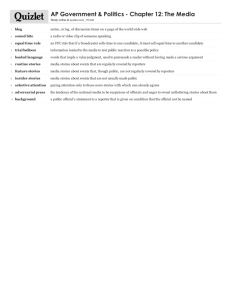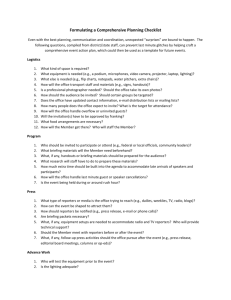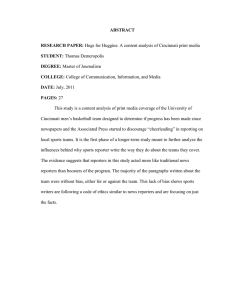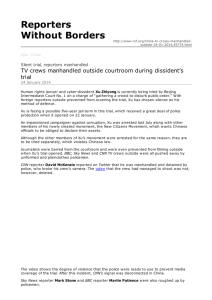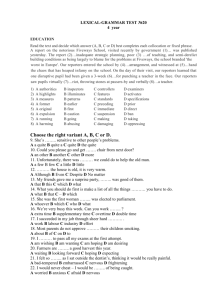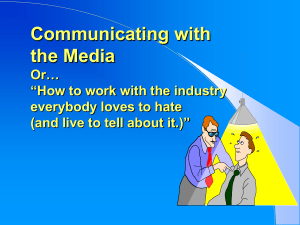‘Being the Other’*or Tourist in her Reality? Reporters’ and Writers’ Elisabeth Eide
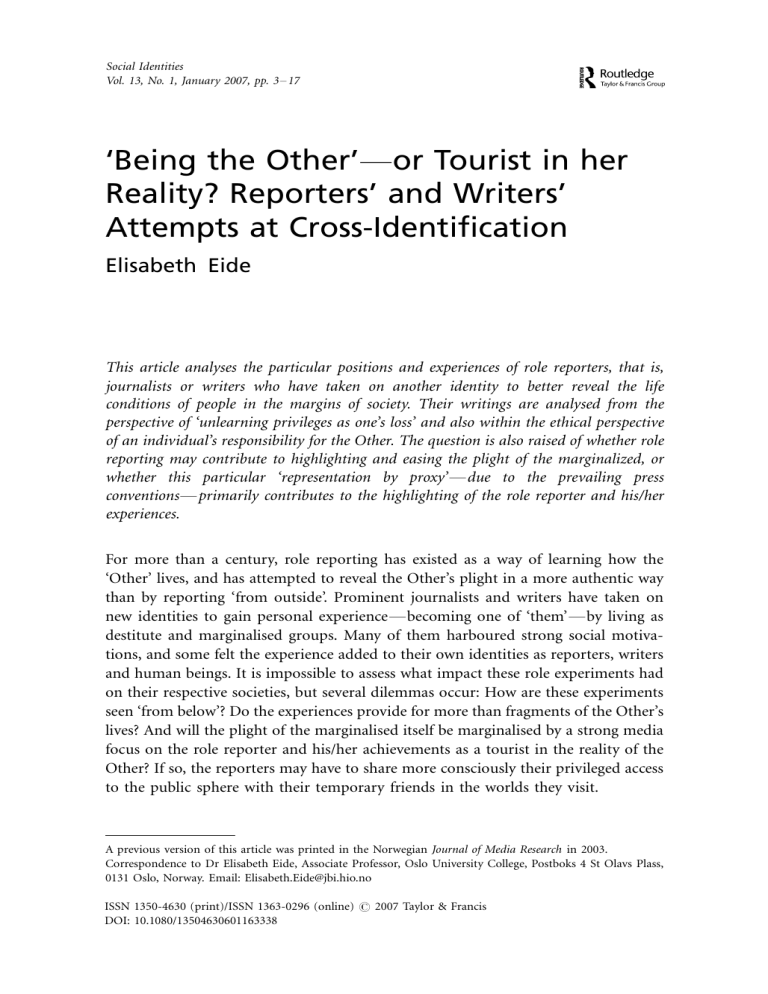
Social Identities
Vol. 13, No. 1, January 2007, pp. 3 17
‘Being the Other’
*
or Tourist in her
Reality? Reporters’ and Writers’
Attempts at Cross-Identification
Elisabeth Eide
This article analyses the particular positions and experiences of role reporters, that is, journalists or writers who have taken on another identity to better reveal the life conditions of people in the margins of society. Their writings are analysed from the perspective of ‘unlearning privileges as one’s loss’ and also within the ethical perspective of an individual’s responsibility for the Other. The question is also raised of whether role reporting may contribute to highlighting and easing the plight of the marginalized, or whether this particular ‘representation by proxy’ * due to the prevailing press conventions * primarily contributes to the highlighting of the role reporter and his/her experiences.
For more than a century, role reporting has existed as a way of learning how the
‘Other’ lives, and has attempted to reveal the Other’s plight in a more authentic way than by reporting ‘from outside’. Prominent journalists and writers have taken on new identities to gain personal experience * becoming one of ‘them’ * by living as destitute and marginalised groups. Many of them harboured strong social motivations, and some felt the experience added to their own identities as reporters, writers and human beings. It is impossible to assess what impact these role experiments had on their respective societies, but several dilemmas occur: How are these experiments seen ‘from below’? Do the experiences provide for more than fragments of the Other’s lives? And will the plight of the marginalised itself be marginalised by a strong media focus on the role reporter and his/her achievements as a tourist in the reality of the
Other? If so, the reporters may have to share more consciously their privileged access to the public sphere with their temporary friends in the worlds they visit.
A previous version of this article was printed in the Norwegian Journal of Media Research in 2003.
Correspondence to Dr Elisabeth Eide, Associate Professor, Oslo University College, Postboks 4 St Olavs Plass,
0131 Oslo, Norway. Email: Elisabeth.Eide@jbi.hio.no
ISSN 1350-4630 (print)/ISSN 1363-0296 (online) # 2007 Taylor & Francis
DOI: 10.1080/13504630601163338
4 E. Eide
1. A Process of Unlearning?
To carry out their research and write their stories, these reporters damaged their own health, they renounced their names and identities, one was almost raped and another became a guinea pig for the chemical industry. They all became famous upon their return to their privileged lives, and their stories gained a large readership. But what did they learn in their position of the Other? Or should we rather ask: was their endeavour part of a process of unlearning ?
Literature professor and critic Gayatri Spivak claims that doing one’s research in the interests of unlearning one’s privilege marks the beginning of an ethical relation to the Other (Landry & Maclean, 1996, pp. 4 5). What does this unlearning entail? It may be interpreted as a rejection of a privileged existence taken for granted, and a willingness to experience the life of the less privileged.
For more than a century, some reporters and writers have carried out their research in a drastic way, by actually taking on another person’s identity. Usually this other person belongs to a lower social class, at times also to a minority. These experiments have taken various shapes. Some individuals changed the colour of their skin and/or eyes, and thereby posed as an ethnic Other. John Howard Griffin and Grace Halsell posed as African Americans in the USA, in Germany Gu¨nter Wallraff became a
Turkish migrant worker. Other reporters presented themselves as someone presumably at the bottom of society * among them author Jack London and Swedish reporter Ester Blenda Nordstro¨m.
This work has gained several labels: ‘role reportage’, ‘participant reporting’,
‘experimenting with the self or with reality’ and even ‘anti-authoritarian action art’. Swedish editors Stig Hanse´n and Clas Thor call role reporting ‘the most difficult, but also the most exiting of all journalistic genres’ (Hanse´n & Thor, 1995). In the following, I shall try to summarise some important experiences from these experiments, and call them role reporting.
Most of the discussion on role reporting has concentrated on the ethics of being undercover, the problems linked to basing journalistic work on a fundamental lie about the reporter’s self * thus provoking situations which would otherwise not have been reported.
Here I shall leave this to one side, and concentrate on other questions. How were these reporters motivated? To what degree may we actually speak of crossidentification? And what other impacts may this kind of journalism generate?
The examples highlighted are all from reporters who experimented with other identities for at least one month, thus excluding shorter stunts, like the few known
Norwegian experiences.
The tradition can be dated back to the late nineteenth century in the USA, and from the 1900s it was inspired by the Chicago School of Sociology. Students were pushed out into hard realities (urban ethnography), taking low-paid jobs, living in the slums of the city and posing as anonymous strangers and thereby getting access to information they would otherwise not have obtained.
Social Identities 5
One may also speak of a German-Austrian tradition from the 1870s, where some reporters became industrial labourers to report on horrible working conditions.
Today the most famous representative of role reporting in this tradition is Gu¨nter
Wallraff. His name has been appropriated to make a new verb in the Nordic countries * to wallraff * rather undeserving, since role reporting started long before he was born.
Some reporters went through a process of trans-culturation * for example, Swiss-
Russian exile Isabelle Eberhardt, who converted to Islam and in her adult years travelled in men’s attire with an Arab name, reporting from the Maghreb countries.
In other words, one extreme of this tradition of reporting may involve years of ‘going native’ for good, like Eberhardt did to a large extent.
The way in which the reporters act whilst ‘down below’ differs. Some reporters mainly concentrate on ‘blending in’ * doing what the Others do, a participant observation of sorts, while some * like Wallraff and Halsell * more actively provoke situations to expose the oppressive forces and mentalities of their societies. Table 1 is an overview of the texts examined.
2. The Whys. Motivation
Grace Halsell, US reporter, whose book Soul Sister from 1969 tells of changing her skin from white to black, thus enabling her to pass as a ‘normal’ Harlem dweller, writes that she wanted to create a story revealing how much alike we all are. And I wanted to do it directly, from the most personal experience, so that I could actually feel the commonality and communicate it to others.
This statement suggests three interrelated motivations. First, a universalistic one: emphasising the likeness of all human beings to each other. In the USA of the 1960s this was still a controversial point of view. The second is an urge for personal experience, presumably motivated by an acknowledgement of the difficulty of empathising with the Other as black from an ethnic white position. Third, through
Table 1 Five role reporters.
From To Who, what and where?
Writer/reporter (male, white), US origin
Reporter (male, white)
Stranded US sailor, slum dweller (white)
Jack London (1903).
London’s East End
People of the Abyss
Farm maidservant (white) Ester Blenda Nordstro¨m (1914).
En piga bland pigor .
1
Sweden.
.
Writer/reporter (male, white)
Writer (black), various
(shoe shine)
John Howard Griffin (1959).
Black like me . Southern USA
Reporter (female, white)
Reporter (German, male,
Various occupations
(black)
Labourer of Turkish origin
Grace Halsell (1968).
Soul Sister . New
York City and Southern USA
Gu¨nter Wallraff (1986).
Aller nederst.
2 white) Industrial West-Germany
6 E. Eide this most personal experience, Halsell feels she would be able to communicate to her readership, presumably mainly white, her sense of ‘being like the Other’ with the authority of direct experience. Thus, her method may be seen as a short cut to the
African-American Other who might otherwise, due to centuries of oppression, reject her or meet her with justified suspicion. The highlighting of a personally felt experience and the authority attached to this is also at the heart of the motivation of other role reporters in this sample.
Halsell’s statement presupposes a very segregated society, by means of life style, privilege, social experience and media consumption. It also presupposes that this role reporting is a better * or indeed more feasible * way of mapping the life of the oppressed Other than venturing into Harlem or the black areas of the Southern states as Grace Halsell, celebrated white reporter. On the other hand, coming visibly from outside, as a reporter, one may ask questions about phenomena that as an insider one would have to take for granted. In spite of this, by seemingly being ‘one of them’
Halsell feels more able to represent the Other, or report on their behalf.
It is not as if the Other has not spoken. Writers like James Baldwin, Langston
Hughes, Zora Neale Hurston and numerous others have published novels and other texts, but one may still speak of a strong degree of marginalisation of African-
American literature, and the mainstream media are to a very large extent manned by majority whites.
In the introduction to her book, Halsell asks herself whether her determination is founded on ‘an unconscious guilt feeling’ or on a professional urge to have first-hand experience.
My emotions answered: I need this experience. I have been on the outside looking in. I have smelled the colored people’s collard greens and their living-up-closetogether smells. I am now going to knock on their doors and say, black people, let me in there with you! (Halsell, 1970[1969], p. 13)
She did not, though, go about it like an active intruder, but in a more modest way, working first in a hospital office. Her ultimate experience was an attempted rape from the father in a Deep South family where she worked as a day labourer with household chores.
John Howard Griffin, who published Black like me seven years earlier, says his work began as a scientific research study of ‘the Negro in the South, with careful compilation of data for analysis’. He filed the data, but published his journal from six weeks of experiences, as he puts it; ‘in all its crudity and rawness’. It seems, as one of his colleagues wrote, his experiences grew on him. He failed to make sense of the journey with an objective, ‘scientific’ approach, which was his original aim. This indicates a more universal experience. When being near or almost ‘one of them’, a researcher may recognise the limitations of the distant, scientific approach. Colleague
Robert Bonazzi writes in an afterword that Griffin became ‘entirely immersed in the experience itself, rather than being the ‘‘I’’ or ego observing some ‘‘it’’ out there’
(Bonazzi, 1996[1962]). He discovered gradually that beneath his own dedication to
Social Identities 7 racial justice, there was an unconscious sense of a (long denied) white supremacy. In other words, a slow process of unlearning seems to have taken place. The inclusion of him in this study of journalism is justified by the fact that he, before undertaking the experiment of becoming black, made a contract with a magazine, in which his accounts of the role experiment were later to be printed as reportage.
Ester Blenda Nordstro¨m writes that she wanted to concentrate not on farm life as such, but on the work and lives of the maidservants. In her preface to her book she expresses her admiration for these human beings and their quiet toiling, which no one who has not tried it knows anything about, and which no one will ever understand nor appreciate unless he has himself been working there * as one of them. (Nordstro¨m, 1914, p. 5)
3
By stating that nobody knows about these toiling women, Nordstro¨m hints at their invisibility in the public sphere. Media professor Terje Rasmussen, in his referral to
Bauman, writes of three alternative fates for the individual: to win, to survive or to disappear. Those disappearing are at times a topic for the journalism of guilt, of remorse (Rasmussen, 2001, p. 171). Rasmussen also claims that modern media transforms us all into tourists who, in a flexible and superficial way, may gaze at people’s ways of living all over the world, this simultaneously granting us cultural resources for our own identity work (p. 172). As I see it, these cultural resources may be meagre, and a long way from the process of unlearning. The question thus remains: may the role reporters offer more than such small fragments, if not something quite different? And may they be motivated by more than guilt?
Jack London, in his preface to The people of the Abyss (1903), describes how he went down into the under-world of the city of London with an attitude of mind akin to that of an explorer. Like Halsell, he also emphasises the supremacy of first-hand experience:
I was open to be convinced by the evidence of my eyes, rather than by the teachings of those who had not seen, or by the words of those who had seen and gone before.
Further I took with me certain simple criteria with which to measure the life of the under-world. That which made for more life, for physical and spiritual health, was good; that which made for less life, which hurt, and dwarfed, and distorted life, was bad. (London, 1903, p. vii)
London explicitly states some criteria for good and bad factors in determining the lives of the Others ‘down there’, a normative point of departure for his reporting, but also emphasises the importance of personal experience. This is echoed by Bonazzi who, in his preface to Black like me , describes Griffin as being an instrument immersed in the experiential moment.
Gu¨nter Wallraff in his preface to Ganz Unten confesses that he has postponed the
Turkish role reporting. This was because he knew from scientific reports how Turkish workers in Germany lived, that their working conditions were beyond belief. ‘But I had never felt it to my body ’
4
(Wallraff, 1986, p. 9). This was not his first endeavour in
8 E. Eide role reporting. In a preface to another of Wallraff ’s books, Heinrich Bo¨ll writes that
Wallraff ‘subjects himself to a situation and describes it from the perspective of the submitted person’ (Bo¨ll, 1972, p. 9). For Wallraff, the choice is one of positioning himself as a victim:
And I always want to take the position of the victim, to expose myself to what I am going to write about. I distrust those who think they can imagine how some people live without trying it for themselves. They are not able to describe the events from the perspective of the oppressed. (Hanse´n & Thor, 1995, p. 54)
Wallraff ’s work comes close to what might be labelled ‘action reporting’. A good proportion of his royalties from Ganz Unten were placed in a fund called ‘Solidarity with foreign workers’, which aimed at financing free judicial and other assistance to these workers. Jack London, besides reporting on the misery of the people of the
Abyss, applies Marxist-inspired sociologist analysis to explain their situation while appealing for social uprising. And Ester Blenda Nordstro¨m proposes some reform for female farm hands, like a day off and more regulated working hours, arguing that farmer’ difficulties in recruiting maid servants might be explained by the lack of such reforms.
The urge for a personal experience and a strong sense of injustice seems to be shared by the role reporters examined here. Does this mean a special sense of responsibility for the Other? When encountering an Other, according to Levinas, I am automatically responsible for him, even if I have not actively chosen this. The responsibility comes before norms, rational choices and interests linked to duties. It occurs when encountering the Other’s face . And when this face is out of sight, as in modern warfare, catastrophe can happen (Rasmussen, 2001). The Other is no longer a fellow human being, the gap is widened. On the other hand, what happens when a reporter, being ranked high in a hierarchical society, tries to understand the Other?
Levinas claims that ethics * that is, responsibility for the Other * must come prior to attempts at understanding, a rejection of the intellectualist model where the human being becomes human by understanding . An alleged understanding * made visible in journalistic text * may be more of an appropriation of an Other which is not the Other. Injustice (albeit well-intended) and paternalism are often seen as a result of not recognising the Other’s right to be different, to her own identity
(Levinas, 1998b).
In a critical discussion of Levinas, Kjell Madsen asks: are not recognition and identification equally important motive powers compared with submitting to responsibility (Madsen in Levinas, 1998a)? I think it is fair to say that one can not here speak of absolutes. If identification is seen as inhabiting the Other’s identity, it is impossible. But may we speak of degrees of understanding , seeing life as being underway both to acknowledge our responsibility and to further understanding?
During an interview, Wallraff says that he never planned his role reporting very meticulously: ‘Most of my roles ‘‘contacted me’’’ (Hanse´n & Thor, 1995). This may be seen as closely related to the ethical imperative of the Other.
Social Identities 9
A reminder now of Spivak’s suggestion, that to do one’s research in the interests of unlearning one’s own privilege marks the beginning of an ethical relation to the
Other. She advocates unlearning one’s privilege by considering it as one’s loss . This marks a meta-perspective on the hierarchies of modern society, since the question asked may be interpreted as: what do these hierarchies make of us human beings?
Our privileges, whatever they may be in terms of race, class, nationality, gender and the like, may have prevented us from gaining a certain kind of Other knowledge: not simply information that we have not yet received, but the knowledge that we are not equipped to understand by reason of our social position. (Landry &
Maclean, 1996, pp. 4 5)
An illustration of this is the way in which Ashis Nandy, Indian professor of social psychology, analyses how the British privileges-as-losses grew under colonialism.
Often, hardness and rigidity won, and the meeker sides of human nature were deemed irrelevant to the public sphere. Values like competition, achievements, control and productivity, new forms of institutional violence, and ruthless social
Darwinism were cherished. The British became more homogenous by exporting their rebels to the colonies; an undeveloped heart separated the British from each other and from the Indians * and the coloniser had the magic feeling of omnipotence and permanence (Nandy, 1990, pp. 33 34). This way of defining loss * as undeveloped empathy and a narrow masculinity combined with violence * is linked to a way of seeing the Other as a distant, dehumanised being. The loss implies not being able to learn to know him or her.
Does seeing one’s privilege as one’s loss entail recognition of the limits of one human existence, framed by a given social reality, an emptiness of sorts; a void which makes us unable to recognise the interdependency of human beings? Maybe so, but it is a recognition with the potential of transcending the limits. This argument that has been put forward by feminists, suggests that rigid boundaries between ‘feminine’ and
‘masculine’ curb individual potential and development.
To take on another identity may be seen as recognition of this interdependency, a way of filling the void by transcending one’s ascribed societal role, taking responsibility for one’s own actions in a very special way, which at best may mean to take responsibility for the Other. But is such an active, conscious ‘responsibilitytaking’ more of a paternalistic appropriation of the Other, in Levinas’ perspective?
There is a fine distinction between helping the Other * to gain control over her own situation * and maintaining a hierarchical relationship and thus helping one’s narcissistic self.
Are the role reporters, if guided by critical self-reflection, able to see from the
Other’s point of view the constraints and limits of their own social position and the way in which this position leaves the bridges to many Others closed or at best halfopen? May they serve as generous keepers with open gates?
In my studies of the five reporters’ work, I recognise two main motives. First, the personal experience found necessary to understand more of the Other’s situation (that
10 E. Eide is, to find out how the Other lives, presumably by being the Other). Secondly, a will to expose something else , an oppressive, discriminatory society, and the conditions of the people living permanently at the bottom of this society. In the first case the reporters risk disappearing too much into their own project, and also that the outer world (the media) will emphasise the role reporter’s sensational work more than the conditions he or she reveals. Method and aim may become blurred, due to the ‘sensationalist’ status of the method and/or the sensationalist hunger of the media. On the other hand, the attempts may also be seen in accordance with what Ashis Nandy calls an alternative universalism, taking as a starting point the experiences of the oppressed
(Nandy, 1990).
3. Being Seen by the Other, Above and Below
The reporters examined how the I persons are seen by individuals who were previously their presumed equals * and by other people at the bottom where they now find themselves. Jack London tells of a particular way of being seen by persons of the opposite sex, who would otherwise have been his potential mates. Together with two acquaintances he is waiting outside a workhouse:
And then, as the last light was fading from the drab-colored sky, the wind blowing cheerless and cold, we stood, with our pitiful little bundles in our hands, a forlorn group at the workhouse door.
Three working girls came along, and one looked pityingly at me; as she passed I followed her with my eyes, and she still looked pityingly back at me. The old men she did not notice. Dear Christ, she pitied me, young and vigorous and strong, but she had no pity for the two old men who stood by my side! She was a young woman, and I was a young man, and what vague sex prompting impelled her to pity me put her sentiment on the lowest plane. Pity for old men is an altruistic feeling, and besides, the workhouse door is the accustomed place for old men. So she showed no pity for them, only for me, who deserved it least or not at all.
(London, 1903, pp. 83 84)
London here explores the limitations of pity. He does not dwell so much on being pitied himself, as on the tragedy of his co-travellers not being worthy of empathy.
The sexual aspect is more visible in Grace Halsell’s experiences, being a black woman caught by the gaze of the white man:
We feel that the eyes of all the white men are upon us, judging us, weighing us, measuring, appraising. It is worse than being judged and priced , because in the eyes of these men we are theirs by birthright. By being born white, they automatically have us as their property. (Halsell, 1970[1969], p. 157)
John Howard Griffin hitches several rides with white drivers in the Southern states of the USA. Some of them approach him with sexual talk, asking him, inter alia , if his wife ever ‘had it’ with a white man, implying that this for her should be a longed-for experience.
Social Identities 11
He told me how all of the white men in the region craved colored girls. He said he hired a lot of them for housework and in his business. ‘And I guarantee you; I’ve had it in every one of them before they even got on the payroll’. A pause. Silence above humming tires on the hot-top road. ‘What do you think of that?’
‘Surely some refuse’, I suggested cautiously.
‘Not if they want to eat * or feed their kids’, he snorted. ‘If they don’t put out, they don’t get the job’. (Griffin, 1996[1962], p. 102)
In this situation Griffin can not speak his mind. He feels at risk as the driver tells of what he and his friends do with dark-skinned troublemakers.
The difference between these experiences, however, and the experience of those people permanently in the situations that Halsell and Griffin want to map, is of course the long-term process of suffering, risk and internalisation. The role reporters can stop their experiment. Halsell is in danger, but she manages to escape from the white man’s house, a black maidservant may have had to endure his sexual violence to provide for her family. On the other hand, the non-permanence of their role reporting also make these reporters less patient, less able to cope with the hardships and oppression.
Being Seen by the Other
*
‘Down Under’ as a Foreigner
At one stage of his wandering in the outskirts of London, being hungry and without shelter, Jack London for a while steps out of his role. He reveals his golden coin, sewn into his jacket, and invites two of his co-fellows for a decent meal. He then has to explain more about himself, and he immediately recognises their change of attitude:
Of course I had to explain to them that I was merely an investigator, a social student, seeking to find out how the other half lived. And at once they shut up as clams. I was not of their kind; my speech had changed, the tones of my voice were different, in short, I was a superior, and they were superbly class conscious.
(London, 1903, p. 86)
London’s description of this encounter tells of the people of the Abyss missing positive experiences with people from the outside their own existence. The class differences were too dominant. Gu¨nter Wallraff experiences a different attitude, being observed by a twenty-year-old Turkish colleague, Yu¨ksel, when he is taking notes during their short breaks. Yu¨ksel encourages Wallraff to continue his work, and in the following days supplies him with information * including his own life story * without interrogating him about his intentions.
4. Seeing (and Being) the Other
* as Equal? (Levels of Identification)
Not all the studied reporters have as explicit an aim as Halsell, of ‘proving’ * as she puts it * the likeness of all human beings. As can be seen from London’s writings, he depicts how the people in London’s East End are crippled both physically and
12 E. Eide psychologically by the horrific conditions they must endure. He gradually becomes convinced that the people at the bottom of society should not marry, should not have children.
At the bottom of the Abyss they are feeble, besotted, and imbecile. If they reproduce, the life is so cheap that perforce it perishes of itself. The work of the world goes on above them, and they do not care to take part in it, nor are they able.
(London, 1903, p. 40)
He concedes that there are spots where a fair measure of happiness may be found, but at the best, it is a dull, animal happiness, the content of the full belly. The dominant note of their lives is materialistic. They are stupid and heavy, without imagination.
(London, 1903, p. 43)
Nordstro¨m on several occasions mentions the dirtiness of both the farm wife and of her bed companion, the other maidservant Anna. She finds these conditions disgusting, and also, maybe unintentionally, includes in her stories very negative characteristics of the farmer himself and about the two mentioned women. She met with severe criticism over this from her employers, who recognised themselves in her stories, even though all names were changed (Sta˚l, 2002).
London’s and Nordstro¨m’s observations are concerned with the historic moment and furthermore, in London’s case, with the fact that he, unlike the other reporters, visits a country which is not his own. He belongs on the other side of the Atlantic
Ocean and poses as a stranded sailor from the USA, where workers earn three times as much as the toilers he observes during his study of London’s destitute. More than
50 years later, Griffin admitted that he looked for ‘inferiority’ among the African-
Americans:
I have looked diligently for all aspects of ‘inferiority’ among them and I cannot find them. All the cherished question-begging epithets applied to the Negro race, and widely accepted as truth even by men of good will, simply prove untrue when one lives among them. This, of course, excludes the trash element, which is the same element everywhere and is no more evident among the Negroes than whites.
(Griffin, 1996[1962], p. 121)
Griffin, in the same way as Halsell, underlines the universality of being human. But as he withdraws from his role he becomes a person of authority. When writing about the
Other, these role reporters, who might to a certain extent be likened to anthropologists, shift from a mutual experience, a kind of dialogue in a ‘shared room’, to the creation of an authoritative version, a monologue characterising the world of the Other. This part of the relation is almost by necessity hierarchical. But the written result does not have to be hierarchical. If the ‘I’, as Bonazzi writes, becomes an instrument immersed in the moment of the experiment, and thus connects the ‘story’ and the reader, so that the reader ‘can imagine the reality by losing the ‘‘self ’’ in this moment’, it will have an effect on our emotions and all our
Social Identities 13 senses (Bonazzi, 1996[1962], p. 190). This may be read as an all-too-positive recommendation of the book, but also as an optimistic view of role reporting, a way of healing the wounds of a given society.
Of course, all the role reporters write from privileged positions, after having shared some of the social conditions of the non-privileged for a while, with the exception of
Wallraff, for a much shorter time than an average anthropological fieldwork period. I find the comparison with anthropologists still valuable, as the common denominator between them and the role reporters is the sharing of the lives of the Other. In both roles it is important to maintain the professional detachment and not ‘go native’. The difference of course, is that anthropologists mostly live among the Others in an open way, and thus do not to the same extent risk being seen as ‘one of them’.
At times the reporters seem to be in a state of enthusiasm in encountering the
Other ‘down there’, which may come close to recognising privileges as precisely a kind of loss * or, alternatively, be seen as signs of ‘gutter romanticism’. Grace Halsell declares her love for Harlem, she writes of her beginning to feel that she belongs there. Griffin highlights the generous hospitality of a black family in Alabama, letting him sleep on the floor in their humble house, and also shows how generously an elderly shoe shine man shares his meal with a beggar.
Ester Blenda Nordstro¨m, at 24, working at least 16 hours a day for a full month, expresses both the admiration she feels for her hard-working colleague Anna, and the joys of the Saturday evening dance events compare favourably with the tango of the city:
Poor all of you back home, I think. In the midst of all your tango, you don’t know what you are missing, you who will never see this, never experience this, never being able to being this * as part of these people. As a maidservant among maidservants.
(Nordstro¨m, 1914, p. 68)
Nordstro¨m, enthralled by a bright summer evening, paints a longed-for experience as an exception to the rule, and soon returns to the hardships of the daily chores, for example the slaughtering of pigs, when she almost drops everything and runs away from the farm, the village, the place * home to civilisation and humanity again.
But then I am embarrassed at giving up so easily, I grind my teeth and continue stirring hastily (in the blood vessel), while the blood wiped on my face is tightening and drying in the sunshine. (Nordstro¨m, 1914, p. 97)
In this passage Nordstro¨m’s sense of belonging is clearly elsewhere, in a civilised urban world far from the observed inhuman practices. All the reporters to a certain extent express both their admiration for the people they encounter ‘down there’ * and their difficulties in coping with being there.
This ‘duality’ underlines the question of how close the reporters could possibly get to the feeling of being ‘one of them’. At times their situation seemed to follow them into the dream world:
14 E. Eide
The nightmare worried me. I had begun this experiment in a spirit of scientific detachment. I wanted to keep my feelings out of it, to be objective in my observations. But it was becoming such a profound personal experience; it haunted even my dreams. (Griffin, 1996[1962], p. 123)
Griffin is an academic. But this study of reality differs from his previous ones by touching him on a more personal level. Wallraff also experiences the sensation of to a certain extent being the Other:
I (Ali) rent a small flat . . .
in Dieselstrasse, Duisburg; I want to further strengthen the adaptation to Ali. I really want to live as a Turkish worker in Western Germany, not only through lasting excursions to the work places. I identify more and more with the role. At night I often speak in broken German in my sleep. Now I know what it costs of resources to tolerate what the foreign workers must endure throughout their whole life. (Wallraff, 1986, p. 85)
In the eyes of people around him, he became Ali, but still deep inside, in his own view, he was not Ali. He learns what the Other has to tolerate and how much contempt he is met with, but he admits that he can not know how a real Ali digests this. His knowledge of the whole internalisation process is missing.
Halsell visits Puerto Rico to speed up the pigmentation effects helped by medical treatment, by more sun exposure. Before entering the ‘Other world’ she is not without fears and hesitations.
I wondered: will this experiment give me skin cancer? Ruin my skin? Split my personality? Destroy my psyche? Then I would raise my bikini straps, jump from my prone position and dive into sparkling waves that seemed to echo my mood of nothing risked, nothing gained. I wanted, as Unamuno had said it, ‘to be someone else without ceasing to be myself ’. (Halsell, 1996, p. 124)
The last phrase may be interpreted as if it were possible to retain one’s own full personality, and also temporarily add a new one. But as Amin Maalouf says, identity can not be thought of in absolutes. The better one learns to know others, the more one also learns to recognize one’s own identity. In discussing the dangers of polarization, Maalouf adds that if people feel they have to choose between denial of the self and denial of the other * then we shall be bringing into being legions of the lost and hordes of bloodthirsty madmen.
(Maalouf, 2000, p. 30)
The more multiplicity one finds in an identity, the more compatible it may grow.
Halsell refuses to choose and claims she has room for both her old self and the Soul sister. Wallraff tells of his childhood, full of deprivation, and a sense of loss of identity. He wonders what it means that he voluntarily ventured into the most extreme and unfamiliar situations without feeling lost. What felt like constraints in the beginning, were later applied in a productive manner:
Social Identities 15
My identity was weak, I had no self-confidence. From all that I have exposed myself to, I have gained an identity and self-confidence. Besides, I now know where I belong, where I want to go and what aims I have. In the beginning I just rushed on.
(Hanse´n & Thor, 1995, p. 60)
But the question of role reporting has other aspects than the development of the reporter’s self, or identity. Beside the Self, there is an urge to change the situation for the Other ‘down there’, and society as a whole. Just communicating a presumed understanding of the Other is a hierarchical exercise. You resort from a one to one communication situation ‘down there’ to represent the Other to the world * and thus the Other loses control. A role reporter risks, by the character of her identityleap, literally to overshadow the experience of the Other who is left in her continuing distress. Thus what should have been a sensational revealing of the living conditions of the Other risks being seen as the sensational deed of a daring individual. The journalist’s method * at least in other reporters’ eyes * should occupy the front stage.
Some reporters take measures for this not to happen * by continuously focusing on fates other than their own in their writings * and by being explicit about the need for reform or more fundamental social change.
5. A Fundamental Dilemma and a Dual Vision?
Julia Kristeva writes that to live with the Other, with the foreigner, confronts us with the possibility or the impossibility of being an Other.
It is not only about our humanistic ability to accept the Other, but to take his place, which means to think and make oneself different from oneself (Kristeva, 1991, p. 28). This seems to have been the ambition of serious role reporters such as those examined here. A role reporter for a while experiences being different from her former self, since that self is not recognised by her new environment.
Still, the problem of representation remains. To what extent will the Other speak, and to what extent is the Other backgrounded? Does a reporter, taking on the role of the Other, to an extreme extent, speak on behalf of this Other, or is the identity-leap a way of letting the Other speak more, a humble attempt to take responsibility and inspire others to do the same? Do the role reporters signify an urge for documentation * or a variety of extreme-sport narcissism? Extreme sport because this living is dangerous. Griffin’s health is said to have deteriorated after his role experiment. Wallraff risked his health in the perilous industries of Western Germany.
Narcissism since the fictitious ‘I’ as the Other is the main person , although the reader meets many other Others, as well. The intentions may be the best, but the role reporter still, because of society’s conventionality, risk becoming a mediator of sorts for the two societies between which (s)he has shifted. In an epilogue from 1977, John
Howard Griffin looks back at the years following the publication of Black like me :
For years it was my embarrassing task to sit in on meetings of whites and blacks, to serve one ridiculous but necessary function: I knew, and every black man there
16 E. Eide knew, that I, as a man now white once again, could say the things that needed saying, but would be rejected if black men said them. (Griffin 1996[1962], p. 172)
To whom do the media ascribe an ethos? Is one reason for role reporting that the media do not attach any credibility to the Other * ‘down there’? As has been shown by numerous researchers, to be heard in the media one should rather be a well-known person from the upper or middle classes, well-versed and well educated. When media presupposes a readership as majority mainstream, minorities who differ from the
‘norm’ may be further marginalised.
At times people rendered voiceless in the public sphere are in a situation where too much risk is involved * of getting sacked, expelled, harassed * and this certainly justifies the experiments. Wallraff and the other role reporters have friends in high places who may defend and rescue them if necessary.
The intentions of role reporting may go far beyond the publication of an ‘account from the inside’. In a wider context, it may be seen as a way of contributing to a public sphere of the oppressed, a liberating counter-sphere to the bourgeois one, as
Wallraff ’s Danish editors express it (Berthelsen & Mailand-Hansen, 1978). Could this have been done without role reporting? A competitor of this genre is the documentary reportage, in which the reporter openly maps the living conditions of people often unheard-of. But at times these open methods are not accessible.
Journalism might thus become poorer without it.
The challenge for future role reporters is to tread a fine line between their urge for unmasking the injustices of society on the one hand, and a society’s urge to insist on the people down below being represented by these reporters, rather than by themselves. If role reporting is to counter marginalisation of the Other with whom the reporters wish to identify, they need to unlearn another privilege * their privileged access to the public sphere * and at least attempt to share it with their temporary co-fellows.
Notes
[1] A maidservant among maidservants.
[2] English title: The lowest of the low .
[3] All translations from this and other texts in Nordic languages are mine.
[4] Translated from the Norwegian edition.
References
Berthelsen, T., & Mailand-Hansen, C. (1978).
Wallraff * maskering og sandhed .
København:
Informations forlag.
Bo¨ll, H. (1972). Forord til Gu¨nter Wallraff.
13 uønskede reportasjer . Oslo: Gyldendal.
Bonazzi, R. (1996[1962]). Afterword. In J. H. Griffin, Black like me . New York: Penguin.
Bourdieu, P. (1993).
Den kritiske ettertanke . Oslo: Samlaget.
Fanon, F. (1986[1952]).
Black skin, white masks .
London: Pluto Press.
Griffin, J. H. (1996[1962]).
Black like me .
New York: Penguin.
Social Identities 17
Halsell, G. (1970[1969]).
Soul sister . New York: The World Publishing Company.
Halsell, G. (1996).
In their shoes . Fort Worth: Texan Christian University Press.
Hanse´n, S. & Thor, C. (1995).
Fo¨rkla¨dd .
Stockholm: Ordfront.
Kristeva, J. (1991).
Fra¨mlingar fo¨r oss sja¨lva .
Lund: Natur och Kultur.
Landry, D., & Maclean, G. (1996).
The Spivak reader , London: Routledge.
Levinas, E. (1998a).
Underveis mot den annen. Essays av og om Levinas ved Asbjørn Aarnes . Oslo:
Vidarforlagets Kulturbibliotek.
Levinas, E. (1998b).
Entre nous: On thinking-of-the-other . New York: Columbia University Press.
London, J. (1972).
Avgrunnens folk .
Oslo: Gyldendal.
London, J. (1907[1903]).
The people of the Abyss .
New York: Grosset & Dunlap.
Maalouf, A. (2000).
On identity . London: The Harvill Press.
Nandy, A. (1990).
The intimate enemy. Loss and recovery of self under colonialism . Delhi: Oxford
University Press.
Nordstro¨m, E. B. (1914).
En piga bland pigor . Stockholm: Wahlstro¨m & Widstrand.
Rasmussen, T. (2001).
Mediesamfunnets moral . Oslo: Pax.
Sta˚l, M. (2002).
Signaturen Bansai. Ester Blenda Nordstro¨m. Pennskaft och reporter i det tidiga 1900talet . Go¨teborg: Institutionen fo¨r journalistik och masskommunikation, Go¨teborgs Universitet.
Wallraff, G. (1980).
Forbrytelsen har navn og adresse . Oslo: Pax forlag.
Wallraff, G. (1986).
Aller nederst . Oslo: Pax forlag.
Wallraff, G. (1995).
Sto¨rning pa˚ga˚r . Stockholm: Legus.
